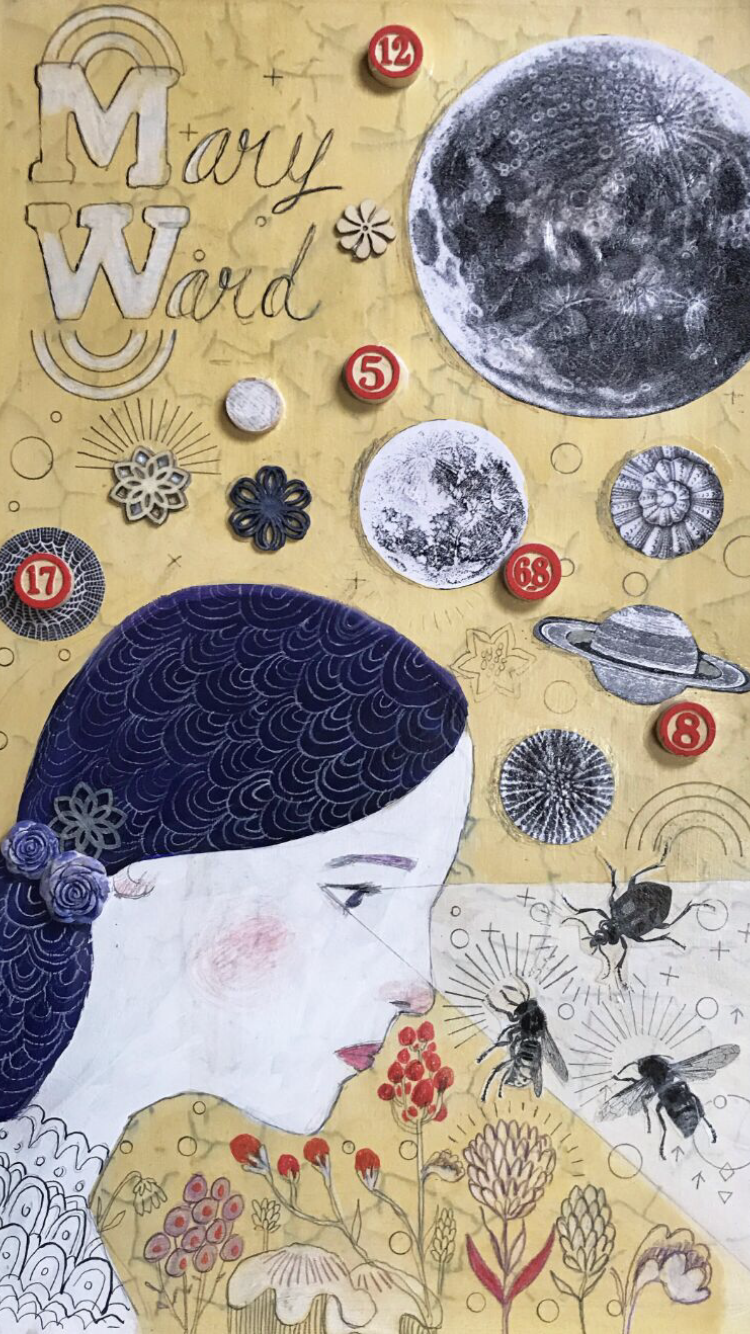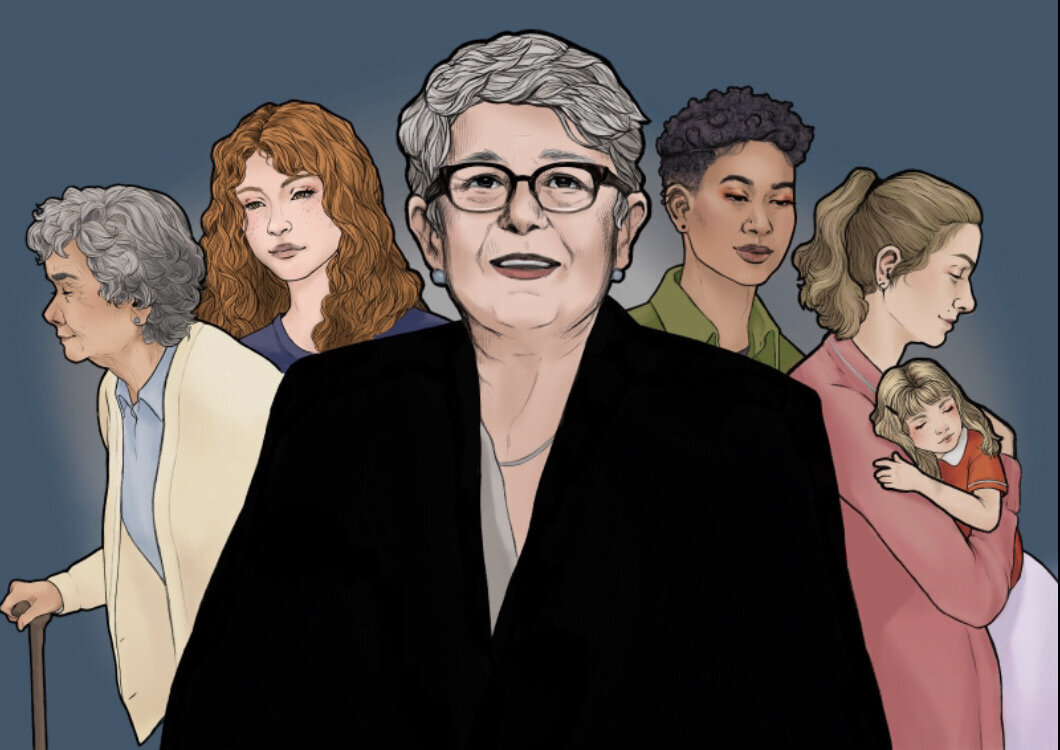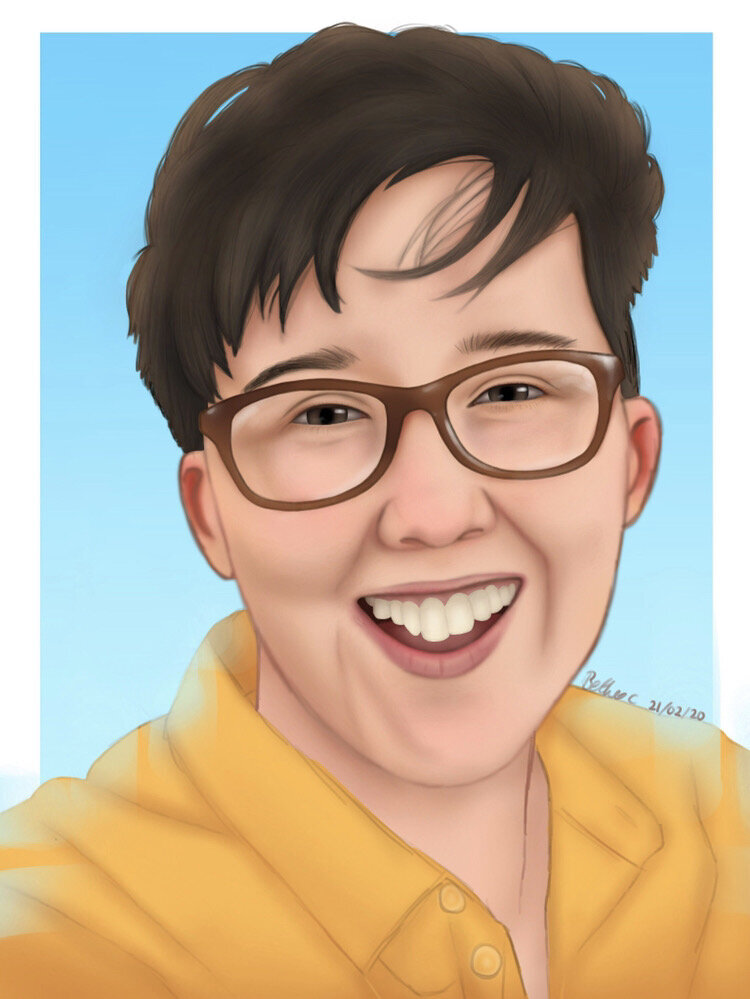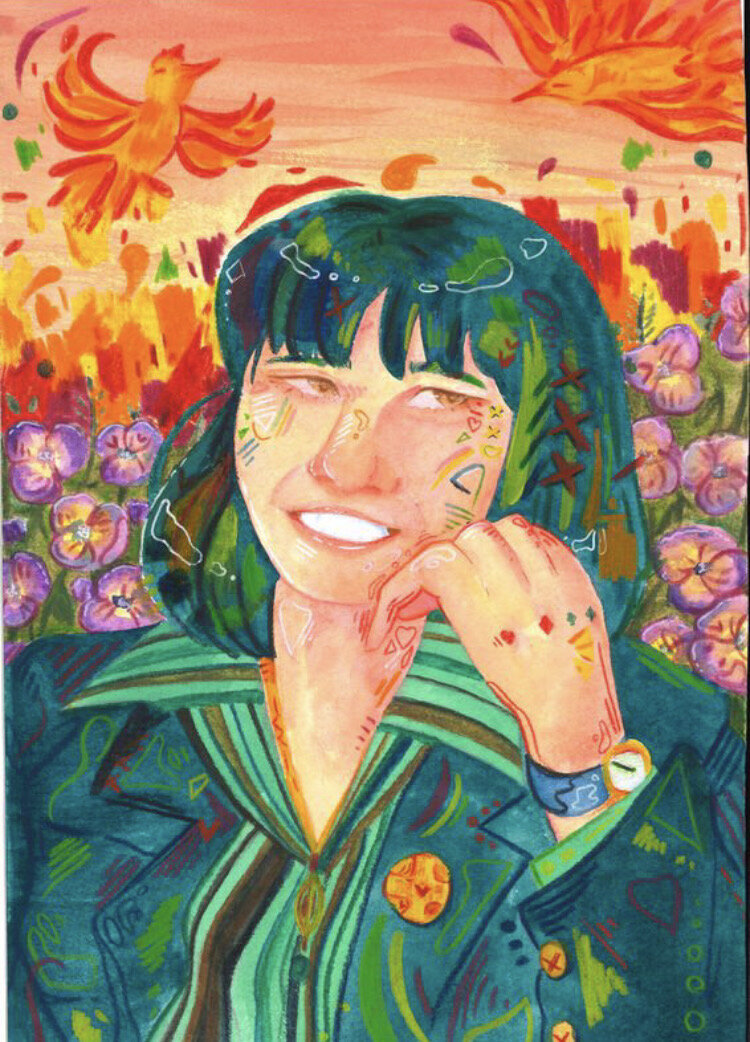Herstory has been blessed over the years with some incredible ‘Herstory Godfathers’ – men who have encouraged, supported and promoted the project. Equality is human nature and when we spot it, we have to celebrate it – so this Father’s Day, we want to celebrate all those fathers who have encouraged and supported their daughter’s in their endeavours.
Mary Ward, illustrated by Adrienne Geoghegan
Mary Ward (neé King) was born in 1827 to Henry King and Harriett Lloyd, in Ferbane, Co. Offaly. Growing up, as she did, in a well-to-do scientific family, Ward developed a great interest in nature. From a very young age, she started collecting insects and using her father’s magnifying glass to study and draw them in great detail. The co-founder of the Astronomical Society of London, James South, took notice of her sketches one day and immediately tried to persuade her father to buy her a microscope. Her father did buy her a microscope, reportedly one of the finest microscopes in Ireland at the time, and microscopy became Ward’s life interest. Similarly, Agnes Mary Clerke, born in 1842 in Cork, developed an interest in astronomy at a young age. Her father, John William Clerke, taught her the basics of astronomy, and she grew up using his telescope for her observations. Clerke became the fifth woman to become a member of the Royal Astronomical Society and her work was internationally recognised.
Oonah Keogh was born in 1903 in Dublin and she went on to become the first woman stockbroker. After some years of study and travel, Keogh was offered a job in stockbroking from her father, who had his own company. As Dr. Angela Byrne wrote, ‘No stock exchange had ever had a woman working in one before […] But Ireland had a new constitution which guaranteed equality and there was no reason to reject Keogh except for her gender. With her education and wealth, she was fully qualified for the role.’ Similarly, Maria Edgeworth, born in about 1768, grew up to work alongside her father, Richard Lovell Edgeworth, as both his assistant in estate management and as a collaborator on a series of educational books for children. From a young age she had been educated on topics such as law, economics, science and politics by her father.
Oonah Keogh. illustrated by Lauren O’Neill
Outside of Ireland, Mary Shelley (neé Wollstonecroft Godwin) was born in 1797 to feminist philosopher Mary Wollstonecroft and writer William Godwin. Her mother died very shortly after her birth and she was raised by her stepmother and father who tutored her and encouraged her education. He had an eclectic library at her disposal and many intellectuals of the time used to frequent their house. At age eighteen, Mary wrote Frankenstein, and it was published when she was just twenty. More recently, Malala Yousafzai was born in Pakistan in 1997. As she said herself, ‘welcoming a baby girl is not always cause for celebration in Pakistan’ but her father, Ziauddin Yousafzai, was ‘determined to give [her] every opportunity a boy would have.’ Ziauddin was a teacher and ran a girls’ school in their village, but when the Taliban took control of their town, girls were no longer allowed to go to school. Malala began to speak out on behalf of girls ‘and our right to learn’ but this made her a target and in 2012 a masked gunman boarded her school bus and shot her in the head. In 2014, Malala and her dad founded the Malala fund ‘a charity dedicated to giving every girl an opportunity to achieve a future she chooses’ and for this, she was awarded the Nobel Peace Prize in December of that year.
Malala and her dad Ziauddin
Some of the women we’ve been championing more recently have told us about the impact their father’s and father-figures have had on their lives. Ellie Kisyombé, co-founder of OurTable, said that while there ‘was no feminism or being feminist’ in Malawi when she was growing up her father ‘raised [her] like [her] brothers’ and raised her to be a go-getter.
Syrian Irish journalist, Razan Ibraheem had two teachers as parents, and according to her, her dad ‘is so pro-women […] he never tried to restrict me…’ She went on to say, ‘…despite my dad's difficult life and poor background in Syria, he worked day and night to educate me and my siblings and dedicated his life to empower us and raise us with values. I would not have been where I am now without his support and his belief in me. I remember his words and carry them everywhere I go:
"Razan! It's your life, your choice."
"Don't ever think you are less than any man on earth."
"Education is your weapon to success."
"Never take anything for granted. Think, question and search."
"Razan! I will miss you, but Go, Go.. explore the world, get new experiences and enjoy the new adventure."
To her dad, Razan said, ‘…daddy, although 4,110.89 km is between us and I have not seen you in five years, you are present in every step in my life.’
Razan and her dad Younes, 2009
Founder of AkiDwA, Salomé Mbugua, grew up in a family of five girls and four boys and she told us that her strong belief in equality came from her father; ‘My father always believed in equality and the way people are treated. He boasted about his daughters and his love towards us was immense. In fact, one day when we were all having dinner, he declared to my mum that he has a very strong love and bond with us, his daughters. Culturally, boys should inherit all from their fathers, but my father declared his wealth to all his children.’ What stayed with her all these years was her father’s ‘kindness and generosity.’ When she was young, he transferred his coffee estate to her mother which made him ‘an extraordinary man’ for in her culture ‘men behave very differently’ and ‘will never transfer any wealth to their wife.’ Salomé was brought up in a rural part of Kenya, about 40 minutes from Nairobi, and talking to us earlier this year she said, ‘…my father believed that people should have equal access to everything. He taught me that you can never hide from the truth. If something is happening and it’s wrong, then speak up! […]My courage and sense of equality, justice and human rights are inspired by my learnings from my father. His words of wisdom and character continue to echo in my head up to today. He was a great man, may his soul rest in perfect peace.’
Salomé and her dad James
Melanie with her dad and siblings
Here at Herstory HQ we’d also like to send our love to our dads who have supported and encouraged us in all of our endeavours. Founder of Herstory, Melanie Lynch, has said: ‘Looking back at my childhood, it’s an anomaly that I founded Herstory. Growing up in our family there was no question that women were equal to men. To be honest, feminism wasn’t even on my radar. I never felt that my gender was a disadvantage. My father had a formative influence on me: gifting my love of music, nature, philosophy and meditation. As a nipper, he would bring me on epic hikes and island escapades to bird-watch and hunt for fossils. Education was paramount and he shaped my worldview with the National Geographic, David Attenborough documentaries and Disney animations. I am the eldest of five and I have three strong, spirited sisters. I confess that my only brother, who is six years my junior, was an outspoken feminist long before me.’
Melanie and her dad
Melanie with her grandfather
Katelyn and her dad Damien, 2018
Project Manager and Researcher, Katelyn Hanna, attributes her love of history to her dad and maternal grandfather; ‘My dad used to always call me his scholar. When I would come home from school he’d ask me ‘How’s my scholar today?’ He was always very encouraging of my education, and still is - to this day if he sees a magazine or article about women’s history he’ll get it for me or show it to me. He introduced me to all the big movies growing up (although I still maintain that I was exposed to Jaws too early!) Last year, when I started to learn Irish again, he got me a handmade framed image that says ‘anam cara’ which means soulmate - it was so thoughtful. We’ve had tough conversations over the years, from the marriage equality and repeal referendums to the more recent Black Lives Matter protests - he will always engage in the conversation with me and I know he reads what articles he can and tries to stay informed, which is very important to me. We’ve influenced each other a lot, and we’re still constantly learning. Just as I see a lot of my dad in my granda, I see a lot of myself in my dad, and I’m now realising how special it is to be able to grow up and become actual friends with your parents and grandparents, and I’m really enjoying that right now. Sláinte, dad.
Katelyn and her dad, 1997
Fiona and her dad
Project Manager in Northern Ireland, Fiona Lowe, said ‘There’s rarely a day goes past when my father doesn’t quote or reference his grandmother. She lived with his family growing up and influenced the admiration he has for strong women. The greatest gift he has imparted to me is a sense of calmness and contentment. I don’t think there is any situation where this can be overestimated. My grandfather (Thomas McGuigan) was a firm advocate of female education. By the time I was born, he was in his eighties and I only had over a year in his arms before he passed. A deep thinker by his very nature, each day he would recite poetry and sing to me on a daily basis. The common denominator that unites the two men is a sense of knowing- knowing unconditional love. It is not derived from words but a knowing smile and a nod. That speaks a lot more to me.
Fiona and her gradad
Jim and his daughter Suzanne
We asked some of Herstory’s Godfathers to tell us about how they’ve influenced and been influenced by their own daughters. Artist Jim Fitzpatrick told us: ‘Of course I would love to think I empowered my daughter but the truth is quite simple enough. My daughter Suzanne was always brought up to believe in equality and the right of women like herself to make their own decisions about their own lives. My own single mother was her inspiration. We have been on the same page on all the important issues relating to women’s rights, LGBTQ rights, abortion rights etc. The only time she threatened to disown me was when Roy Keane (her hero) walked out in Saipan: ‘You’re lucky we agree on this one, Dad, because I would have disowned you if you didn’t support Keano’. Yep, Roy was my hero too...luckily :) Right now we’re separated by the coronavirus (she lives in Italy) but she is and always has been my own guardian angel, always watching out for me and when I had cancer guess who took weeks off to stay with me and look after me? Yep my amazing daughter.’
Jim Fitzpatrick and his daughter Suzanne
Thérese and her dad, John Ennis
Thérese Casey, daughter of poet John Ennis (another Herstory Godfather) told us about her dad, ‘Always a kind, hardworking resilient father with strong beliefs in the value and importance of education, guiding us to believe in what we could achieve. All the family have accomplished a lot academically and in our fields of work. Guiding us in trying to do what is right with a strong sense of morals. Happy memories of home of my Mum and Dad, a happy peaceful home where we enjoyed the early years of our lives. Lovely memories of trips to Ballybunion (Kerry), the Comeragh Mountains, Woodstown beach, happily playing on the family farm in the fields of Coralstown (Mullingar) in my father's birthplace.’
John Ennis’ daughters, Thérese, Fiona and Ann Marie
Szabolcs Kariko, yet another Herstory Godfather who created some gorgeous artwork and illustrations for Herstory over the past few years, shared with us his thoughts on equality, and growing up in the Eastern Block in the 1980s: ‘Perhaps the only advantage of communist rule in Eastern-Europe was the gender equality. After the Russian occupation of Hungary, equal treatment was expected between comrades regardless of sex. To encourage women to take up “manly” jobs, posters inviting “girls” to drive a tractor and to work in a factory appeared in the 1950s. Growing up in the Eastern Block in the 80s, I haven’t asked any questions about feminism. The women of my family were independent, cultivated. My grandmothers both studied before the world war, and my mother was one of the first female computer engineer in the country.
Thanks to them it never occurred to me that women may be less equal than men. […However] Working as a freelance art director, I was once contacted by a client to do a series of posters of inspirational quotes to motivate the employees. I was surprised to learn that between the 50 famous people quoted, there was only one female. When I pointed it out to the client, I got the answer that they couldn’t find enough inspiring women. So I did the research for them and found 50 women worth being quoted : there were activists, artists, Nobel-prize laureates and CEOs. Women who excel in their work and they are still unnoticed and ignored.
Talking to my girlfriends, they often complain about not getting heared. Even though I’m a quiet and introverted person, I never had to face this problem. Society is still trained to listen more to men than to women. That’s why I found it important that as men we lend our voices to talk about existing problems, to make things evolve and to be able to stand together in the sun. And not in the shadows.’
On Father’s Day, Herstory wants to acknowledge and thank Herstory’s Godfathers who have played an instrumental role in the formation and success of Herstory to date. In the true spirit of equality, they have created portraits, penned biographies, opened doors, forged partnerships and funded projects. Herstory simply wouldn’t exist without their support.
Heartfelt thanks to James Harrold, Stephen Plunkett, John Ennis, Justin Lynch, Szabolcs Karikó, Seán Branigan, Courtney Davis, Jim Fitzpatrick, Bill Felton, Mervyn Greene, Neville Isdell, Patrick Greene, Darragh Doyle, Nathan Mannion, Cormac Bourke, Andrew Simpson, Damien Duffy, Donal Maguire, Sandy Dunlop, Geoff Fitzpatrick, Jeff O’ Riordan, Callum Mathieson, David Clarke, Justin Moffitt, Marty Mulligan, Rónán Nelson, Ruairí McKiernan, Patrick Carton, Conor Plunkett, Conor English, Derek O’ Connor, Adrian Lynch, Neil Leyden, Aron Hegarty, Oisín Ryan, Padraic Vallely, Duncan Walker, Derek Dignam, John Mc Cullagh, Christopher Campbell, Simon Coveney, Cian Connaughton, John Kennedy, Rónán Whelan, Tim Lucey, Paddy Matthews, Lee Breslin, the Lord Mayors of Dublin and President Michael D. Higgins.
On Father’s Day, Sunday 21st June at 7pm, Herstory invites you to a special online event in honour of the fathers who have empowered their daughters throughout the centuries and Herstory’s Godfathers who have played a pivotal role in co-creating the Irish Herstory movement. Equality is human nature and when we spot it, we have to celebrate it!
Join us for a fascinating evening of storytelling and conversation with poet John Ennis, artist Jim Fitzpatrick, celtic wisdom keeper Mari Kennedy, activists Ellie Kisyombé and Salome Mbugua, co-founder of Bard Mythologies Sandy Dunlop, and more.
Sources and further reading:
Hanna, Katelyn, ‘Mary Ward,’ online at: https://www.herstory.ie/news/2020/2/11/mary-ward?rq=mary%20ward [accessed 10 June 2020].
Byrne, Angela, ‘Herstory: Agnes Mary Clerke - 1842 - 1907: Science writer and astronomer,’ online at: https://www.rte.ie/culture/herstory/2019/0903/1073606-herstory-agnes-mary-clerke/ [accessed 11 June 2020].
Byrne, Angela, ‘Herstory: Oonah Keogh - 1903 - 1989 - the first woman stockbroker in the world,’ online at: https://www.rte.ie/culture/herstory/2020/0127/1111240-herstory-oonah-keogh/ [accessed 10 June 2020].
Keon, Edwina, ‘Maria Edgeworth,’ online at: https://www.ria.ie/news/dictionary-irish-biography/dib-entry-day-maria-edgeworth [accessed 11 June 2020].
Yousafzai, Malala, ‘Malala’s Story,’ online at: https://www.malala.org/malalas-story [accessed 11 June 2020].
Yousafzai, Ziauddin, ‘What Being Malala's Father Taught Me About Feminism,’ online at: https://time.com/5605625/malala-yousafzai-father/ [accessed 11 June 2020].
Pollak, Sorcha, ‘New to the Parish: Observing the Syrian war ‘is like watching your child dying,’ online at https://www.irishtimes.com/life-and-style/people/new-to-the-parish-observing-the-syrian-war-is-like-watching-your-child-dying-1.2675641?fbclid=IwAR2kJ655hM8xR7hHS11XuGUePHV_TbGmP96WMHt67cFIKXXU6pHG7_yD-ek [accessed on 11 June 2020].
Hanna, Katelyn, ‘Interview with Salomé Mbugua,’ online at: https://www.herstory.ie/modern/2020/2/4/salome-mbugua?rq=salome [accessed 11 June 2020].
Thank you to Ellie, Razan, Salomé, John, Therese, Jim, and Szabolcs for sharing with us a few lines on their relationships with their dads/daughters for this photo essay.












































![Postcard to from Mainie Jellett to ‘Miss H. Clarke’ [Margaret Clarke], 25 August 1937.](https://images.squarespace-cdn.com/content/v1/55f6f3f9e4b0304fcdd9d938/1581425440727-NVQ0PIB5OS3RKHLBYLZG/image8.JPG)











































